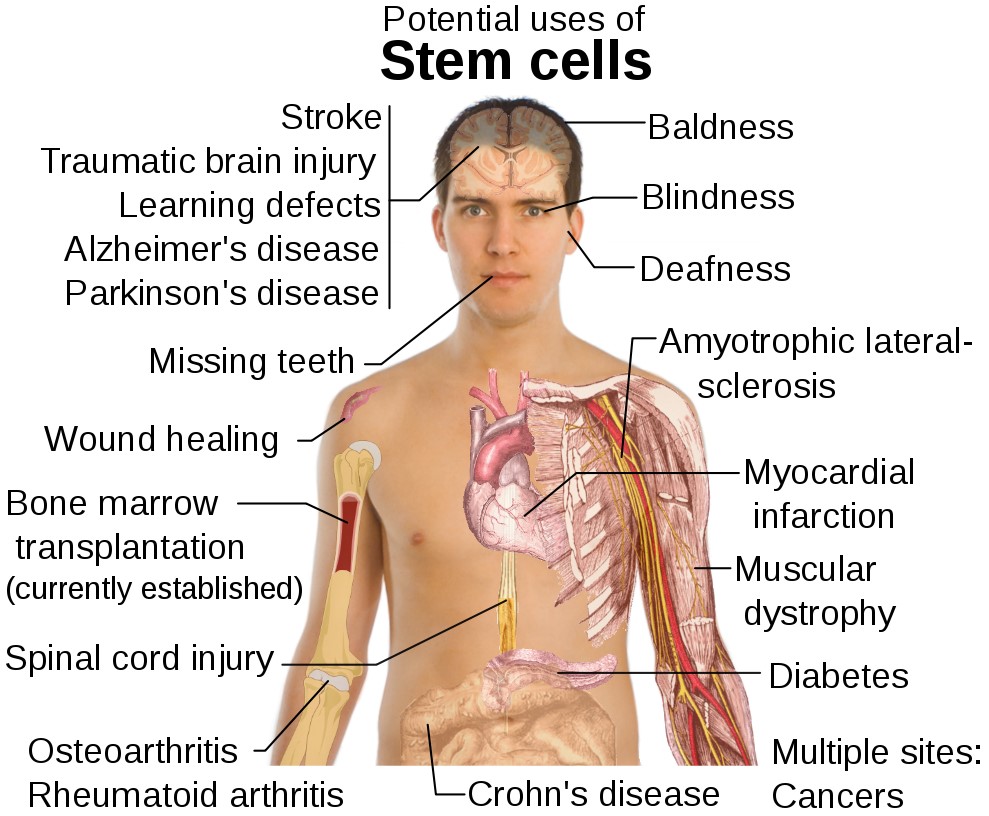Stem Cells

A diagram of the various body systems that have shown potential benefit from stem-cell based treatments. Note that bone-marrow transplants are the only currently established treatment using stem cells.

I’ve been seeing a lot of news lately about stem cell treatments. This week I want to focus what they are, where they come from, how they might be used to treat disease and finally, the social and ethical challenges surrounding their use.
Stem cells are cells that have the potential to change into other more specialized cells in the body through a process known as differentiation. By definition, stem cells have to exhibit two properties: (1) they must be able to divide multiple times and remain unchanged and (2) they have to have “potency,” the ability to differentiate into other cell types.
Stem cells have a hierarchy of potency that is important in determining what they are capable of doing. Totipotent cells sit at the top of the pyramid and have the capacity to differentiate into any of our 220 cell types. Pluripotent cells can differentiate into nearly all cells, and multipotent cells can become only cells of a closely related family of cells. There are additional levels of potency that produce even fewer cell types.
There are two types of stem cells in humans – embryonic and adult. Embryonic stem cells are derived from embryos that are 4-5 days old. Embryos at this stage contain about 50 to 150 cells, some of which are pluripotent and can propagate indefinitely.
Adult stem cells are found in most tissues in the body and are multipotent. They are generally able to produce all of the cell types of the organ where they reside. They can also be found in umbilical cord blood. These cells exist to replace and repair tissues. It is also hypothesized that they may bear some responsibility for development of some cancers.
Stem cells are removed from either embryos or tissues of the body and then grown in the lab in tissue culture. This is a very tricky business, as stem cells naturally want to differentiate into other cells. The stem cells need to be kept in a very specific biochemical soup to prevent them from differentiating. One of the most challenging facets of stem cell research is discovering the complex biochemical signaling that controls stem cell differentiation.
The excitement surrounding the use of stem cells arises from the potential they have to replace damaged or genetically defective cells and tissues in the body. Most readers are familiar with bone marrow transplantation. Currently, this is the only medically approved treatment using adult stem cells.
There are no currently approved embryonic stem cell treatments. However, the first human study using embryonic stem cells was started a few years ago. It involved placing stem cells around damaged nerves in patients with spinal cord injuries.
There are a number of potential challenges in using embryonic stem cells. One is discovering how to program the stem cells to differentiate into the desired cell type. Stem cells can differentiate into masses of different cell types and tissues if allowed to grow on their own. If a patient receives stem cells from another person, there is also the risk of rejection by the recipient’s immune system.
Finally, embryonic stem cell research presents social and ethical challenges in regard to obtaining stem cells from human embryos. Until recently, removing the stem cells had resulted in destruction of the entire embryo. A technique was developed in 2006 that allows the embryo to survive following removal of stem cells.
Recent research has developed a methodology to produce pluripotent stem cells from fully differentiated cells. These reverse-engineered stem cells are called induced pluripotent stem cells. Scientists have taken skin cells and added various proteins to alter DNA expression to cause the skin cells to revert to stem cells. This discovery is very exciting and has the potential to obviate the need to use embryonic stem cells.
You may run across medical clinics that claim to offer stem cell therapies. Since using stem cells for treatment of diseases is in its infancy and there is no good evidence they are to the point they are safe and effective, it is a very questionable practice. The FDA is really cracking down on stem cell clinics. Consumer Reports had an excellent review in January 2018 that you can read at goo.gl/vfZfvv.
– Dr. John Roberts is a member of the Franciscan Physician Network specializing in Family Medicine as well as the Deputy County Health Officer in Montgomery County
